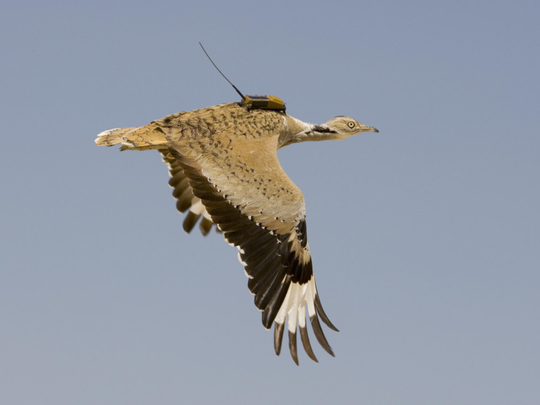
Dubai: Once on the brink of disappearing in the UAE and beyond, migratory Houbara bustard populations have rebounded, thanks to the introduction of 250,000 birds bred in captivity and released into the wild by Abu-Dhabi-based International Fund for Houbara Conservation (IFHC).
Today, untold numbers of the birds flock from Asian countries to the UAE to winter in warmer climes and this is a testament to decades of work to bring back the Houbara, said Ali Mubarak Al Shamsi, acting head of Communications and Public Relations at IFHC.
It’s one of many success stories being celebrated on May 10, World Migratory Bird Day, held every year to recognise efforts to protect bird species, their resting sites and habitats along the many wintering routes.
Organisers of the Migratory Bird Day said they laud efforts such as the IFHC to protect birds on often perilous journeys to their wintering grounds.
“Migration is a perilous journey and exposes the animals to a wide range of threats, often caused by human activities. As migratory birds depend on a range of sites throughout their journey along their flyway, the loss of wintering and stopover sites could have a dramatic impact on the animals’ chances of survival,” said World Migratory Bird Day organisers in a statement. “Flying long distances involves crossing many borders between countries with differing environmental policies, legislation and conservation measures. International cooperation among governments, NGOs and other stakeholders is required along the entire flyway of a species in order that knowledge can be shared and conservation efforts coordinated.”
Such conservation results are clear when it comes to captive breeding projects to bring back the Asian Houbara by the IFHC, said Al Shamsi.
“From a dire population, we were able over the decades to breed and release several hundred thousands of Houbara bustard. We have produced over 250,000 North African and Asian Houbara in our breeding centres and as such we have seen unprecedented success in our abilities to conserve the Houbara and protect it,” Al Shamsi told Gulf News.
“The population of the Houbara was very dire when the first initiatives were established to conserve them. The late Shaikh Zayed Bin Sultan Al Nahyan was the first to notice in 1970 that the population of the Houbara was declining rapidly and proposed a breeding programme to prevent the extinction of the Houbara across territories of distribution from Morocco to China. In 1977, a Houbara breeding unit was set up in Al Ain Zoo and, in 1982, the first Houbara chick was hatched from the breeding programme.”
To complement the breeding programme, newly released birds were fitted with small tracking devices to further understand the bird’s migration patterns to boost numbers even further, he said.
The Asian Houbara is tracked from migration routes from across China and Mongolia to the UAE.
“We began the satellite tracking programme in the mid-1990s and because of it have been able to compile large amounts of data about the Houbara which have led us to enhancing our breeding rates as well as to follow up on the behavioural habits of the Houbara bustard after they are released into the wild,” said Al Shamsi.
Measuring visiting numbers of Houbara migration is still difficult, he said, because the bird does “not have set stopover sites; therefore, we never know whether they will visit the UAE every year. As a result, there is no set figure for how many Houbara visit the UAE yearly”.
“The Houbara bustard is an integral part of our cultural heritage and it is important to save them as part of preserving our culture and desert physiognomy for the future generations to come,” Al Shamsi said. “We are keen to preserve our Arab and desert traditions and the conservation of the Houbara bustard is one of the ways we achieve this.”













